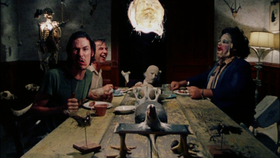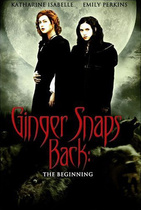Our editor-in-chief Nate Yapp is proud to have contributed to the new book Hidden Horror: A Celebration of 101 Underrated and Overlooked Fright Flicks, edited by Aaron Christensen. Another contributors include Anthony Timpone, B.J. Colangelo, Dave Alexander, Classic-Horror.com's own Robert C. Ring and John W. Bowen. Pick up a copy today from Amazon.com!
The Texas Chain Saw Massacre: Revenge of the Silent Majority
Tobe Hooper's The Texas Chain Saw Massacre is an intense, bare-knuckled assault on the senses. In it we see sadism, brutality, and violence as we had never seen it before. What is sometimes overlooked is that one can see in the film a grotesque mirror being held up to the social struggles of the era. The late 1960s and early 1970s were a stressful time for America. The Freedom Struggle, the tragic war in Vietnam, the epidemic of violence in the country, the bloody trend of political assassinations; all of these things had led by the mid '70s to a sense of fatigue and despondence in the country. In 1969, Richard Nixon used the term "silent majority" to encompass those Americans who had become uncomfortable with all of the drastic changes that the country had come through. He gave a name to those not claiming membership in the left-leaning Counterculture or who participated in demonstrations.1 The excesses of the past decade had built up a sense of victimization and resentment within the Silent Majority. The Texas Chain Saw Massacre can be seen as a reflection and parody of the clash between these two groups.
Of all of the massive changes brought by the many social movements of the 1960s, perhaps none were more visible than the Counterculture. While it was deeply involved in the Civil Rights Movement, it was the combination of their protest of the Vietnam War and their "sex, drugs, and rock and roll" sentiments that really made the Counterculture a visible force in the country. Hippies and minorities challenged many of the assumptions of American society. The Counterculture was also heavily involved in many of the violent clashes of the '60s, including the violence at the 1968 Democratic convention, a violent struggle at Columbia University in 1968, and the tragic killing at Kent State University in 1970.2 The Counterculture, in many peoples' eyes, had pushed the nation to the breaking point.
By late 1969, the anti-war movement had attracted so much attention that President Nixon believed that he needed to address it head on. Going on national television on November 3, 1969, Nixon appealed to what he called the "great silent majority" of Americans to support his Vietnam policies. His speech was more effective than he had imagined. For weeks after the address, the White House continued to receive telegrams and letters mentioning the "silent majority" favorably and offering their support.3 Many in the country that had chafed against the excesses of the Counterculture had found a home in the Silent Majority.
The Silent Majority encompassed elements of the so-called "white backlash" against the '60s various movements. Many whites left the cities, and Nixon had run a victorious campaign in 1968 based on, among other things, curbing the programs of Lyndon Johnson's "Great Society."4 The Silent Majority was also ready to fight back against the counterculture. Perhaps the best example of this was the "Hard Hat Riot" of May 8, 1970. Some 200 construction workers violently broke up a student demonstration near City Hall in New York City. They chased many of the students and beat some of those with long hair severely. In the end, over 70 people were injured.5 It seemed that, by the early '70s, the members of Nixon's Silent Majority had had their fill of the Counterculture and were ready to violently fight back against it.
In some ways, The Texas Chain Saw Massacre can be seen as a horror film version of the Hard Hat Riots. The first evidence we have of this is in the identities of the victims and the killers in the film. The victims here are all kids who, in one way or the other, are examples of countercultural stereotypes that the Silent Majority hated. One character, Pam (Teri McMinn) talks about the effects of astrology, which was seen by many as a symbol of the Counterculture.6 Jerry (Allen Danziger) sports a huge Afro, and the kids travel in what looks like a hippie van. Overall, the victims here, with the possible exception of Paul Partain's Franklin, are mild examples of the Counterculture. We don't see any drugs, but we hear rock music and it seems that Pam and Kirk (William Vail) are looking for a place to have sex. The film does not condemn the lifestyles of the kids; rather it presents them as symbols of many of the things that the Silent Majority hated. As seen in this film, the counterculture is viewed as good but naïve, contrasted with the killers, who are anything but.
Extremes tend to make lasting impressions, and if the kids in the film can be seen as a very nice and pleasant image of the counterculture, the killers can be viewed as an image of the Silent Majority pushed to an absurd extreme. Early in the film, the Hitchhiker (Edwin Neal) talks about how his whole family was "in meat" and how new slaughterhouse technology has "people put out of jobs," echoing the sense that the Silent Majority was being left behind by the new post 1960s world.7 The cannibal family seems to have been reduced to running what appears to be a failed gas station that serves suspicious "barbecue,"8 and it reveres its grandfather (John Dugan) as a kind of slaughterhouse John Henry who could kill more cows than anyone else. They symbolize in many ways the ways that many of the poor, blue collar workers were feeling at this time.9 They see their best days behind them, and are now scrabbling to survive in a world in which the feel irrelevant.
The family, rather than try to adapt to the new world in which it finds itself, reacts instead by exacting revenge against the symbols of the new order. Midway throughout the film, Pam and Kirk discover the family's home. Surrounding it are cars, watches, and many other items that the family had apparently kept from previous victims. They are perversely keeping the artifacts of a world that they believe has left them behind. The family has apparently been taking its revenge against the new world for some time. The climax of the film, in which the family terrorizes and tortures the hapless Sally (Marilyn Burns) can be viewed as the ultimate revenge against a symbol of the counterculture. Leatherface (Gunnar Hansen), the Hitchhiker and their brother, the Old Man (Jim Siedow), along with their grandfather torture and torment Sally with perverse delight before they attempt to kill her in the manner that the grandfather used to slaughter cattle. We can see here essentially powerless and marginalized people acting out in the only way they know how against a new world that has rendered them obsolete. Again, rather than try to understand and adapt to a changing world, the family, who in this reading is a symbol of the Silent Majority, only tries to take revenge against the symbols of the counterculture that it encounters. It is unlikely that Tobe Hooper and Kim Henkel had these ideas explicitly in mind when they created this film, but this author believes that they are in the film nevertheless.
The film's conclusion continues the metaphor. Sally escapes from her captors, and is rescued by a large African-American man in a truck, while Leatherface swings his chainsaw in impotent rage. In the scene, we can see the symbol of the Silent Majority and the White Backlash defeated by two symbols of the Counterculture. Leatherface's furious dance of frustration can be seen as a final howl of rage against the society that has left him in the ashcan of history. Since it is never intimated that the kids somehow deserved their fate (as is sometimes the case in later slasher films), what we see here is that the symbols of the Silent Majority are simply attacking the symbols of the new world that they no longer fit in to or understand.
In sum, The Texas Chain Saw Massacre can be viewed as a comment on the "Silent Majority" of the '60s and '70s. We see the symbols of that Silent Majority taking out revenge upon symbols of the Counterculture that so enraged them. The cannibal family is seen here as symbolic of the rage and feeling of impotence of the Silent Majority taken to a ridiculous and graphic extreme. While the film's auteurs probably did not specifically mean to include these rather metaphoric ideas, they nevertheless slice and dice their way to the surface.
- Nevin, Mark. "The Making of the Silent Majority: Nixon, Polling, and Constituency Building." Midwest Political Science Association, 2007. Retrieved October 5, 2010. <http://www.allacademic.com/meta/p196625_index.html> (back)
- Oracle Thinkquest. "The Counterculture and the Antiwar Movement." Oracle Thinkquest. Publication date unknown. Retrieved October 5, 2010. <http://library.thinkquest.org/27942/counter.htm> (back)
- Nevin. (back)
- Digital History. "America in Ferment: The Tumultuous 1960s -- White Backlash." Digital History. Publication date unknown. Retrieved October 5, 2010. <http://www.digitalhistory.uh.edu/database/article_display.cfm?HHID=373> (back)
- Bigart, Homer. "War Foes Here Attacked by Construction Workers; City Hall is Stormed." The New York Times 09 May 1970: A1. Available online. (back)
- Wuthnow, Robert. "Astrology and Marginality." Journal for the Scientific Study of Religion. 15.2 (1976): 157. (back)
- "Man and Woman of the Year: The Middle Americans." Time Magazine January 5, 1970. Available online. (back)
- It is not made explicit that the family is serving human barbeque, although it is made explicit in The Texas Chainsaw Massacre 2. (back)
- It seems important to state here that this author is not asserting that the Silent Majority was composed of sadistic, cannibalistic killers. I am asserting that the family in The Texas Chain Saw Massacre can be seen as the rage and intolerance of the Silent Majority taken to a Swiftian extreme. (back)









WUBBISH! WUBBISH!!!!
WUBBISH! WUBBISH!!!!
Very inciteful look. There is
Fantastic assessment. Then
Fantastic assessment. Then again, it's much the same as my take-away from it as well.
I'd go as far as to suggest that Franklin's "sin" to the Silent Majority was feeling sorry for himself (and not themselves) as disabled and expecting help for something that wasn't their fault (not that it was his). We've certainly seen plenty of this same kind of victim-blaming language from the Tea Party in recent years. It was always there, but they're just more out-in-the-open about it now as the counter-counter-cultural redneck culture war continues unabated.